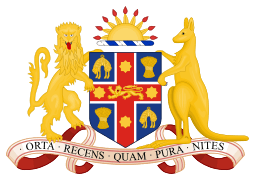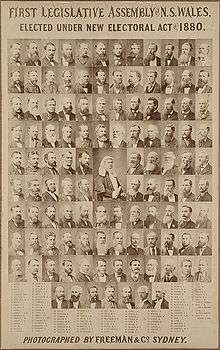New South Wales Legislative Assembly
The New South Wales Legislative Assembly is the lower of the two houses of the Parliament of New South Wales, an Australian state. The upper house is the New South Wales Legislative Council. Both the Assembly and Council sit at Parliament House in the state capital, Sydney. The Assembly is presided over by the Speaker of the Legislative Assembly.
New South Wales Legislative Assembly | |
|---|---|
| 55th Parliament | |
 | |
| Type | |
| Type | |
| History | |
| Founded | 1856 |
| Leadership | |
Leader of the House | |
Manager of Opposition Business | |
| Structure | |
| Seats | 93 |
.svg.png) | |
Political groups | Government (48)
Opposition (36)
Crossbench (9)
|
| Elections | |
Last election | 23 March 2019 |
Next election | 25 March 2023 |
| Meeting place | |
| Legislative Assembly Chamber Parliament House, Sydney, New South Wales, Australia | |
| Website | |
| NSW Legislative Assembly | |
The Assembly has 93 members, elected by single-member constituency, which are commonly known as seats. Voting is by the optional preferential system.[1]

Members of the Legislative Assembly have the post-nominals MP after their names.[2] From the creation of the assembly up to about 1990, the post-nominals "MLA" (Member of the Legislative Assembly) were used.
The Assembly is often called the bearpit on the basis of the house's reputation for confrontational style during heated moments and the "savage political theatre and the bloodlust of its professional players"[3] attributed in part to executive dominance.[4]
History

The Legislative Assembly was created in 1856 with the introduction of a bicameral parliament for the Crown Colony of New South Wales.[5] In the beginning, only men were eligible to be members of the Assembly, and only around one half of men were able to pass the property or income qualifications required to vote. Two years later, the Electoral Reform Act, which was passed despite the opposition of the Legislative Council, saw the introduction of a far more democratic system, allowing any man who had been resident in the colony for six months the right to vote, and removing property requirements to stand as a candidate.[5] Following Australia's federation in 1901, the New South Wales parliament became a State legislature. Women were granted the right to vote in 1902, and gained the right to be members of the Assembly in 1918,[6] with the first successful candidate being elected in 1925.[7]
Chamber
The Legislative Assembly sits in the oldest legislative chamber in Australia. Originally built for the Legislative Council in 1843, it has been in continuous use since 1856. The colour of the Legislative Assembly chamber is green, which follows the British tradition for lower houses.[8]
Function
Most legislation is initiated in the Legislative Assembly. The party or coalition with a majority of seats in the lower house is invited by the Governor to form government. The leader of that party subsequently becomes Premier of New South Wales, and their senior colleagues become ministers responsible for various portfolios. As Australian political parties traditionally vote along party lines, most legislation introduced by the governing party will pass through the Legislative Assembly.[1]
As with the federal parliament and other Australian states and territories, voting in the Assembly is compulsory for all those over the age of 18. Elections are held every four years on the fourth Saturday in March, exceptional circumstances notwithstanding, as the result of a 1995 referendum to amend the New South Wales Constitution.[1]
Current distribution of seats
| Party | Seats held | Current Assembly | ||||||||||||||||||||||||||||||||||||||||||||
|---|---|---|---|---|---|---|---|---|---|---|---|---|---|---|---|---|---|---|---|---|---|---|---|---|---|---|---|---|---|---|---|---|---|---|---|---|---|---|---|---|---|---|---|---|---|---|
| Australian Labor Party | 36 | |||||||||||||||||||||||||||||||||||||||||||||
| Liberal Party of Australia | 35 | |||||||||||||||||||||||||||||||||||||||||||||
| National Party of Australia | 13 | |||||||||||||||||||||||||||||||||||||||||||||
| Greens New South Wales | 3 | |||||||||||||||||||||||||||||||||||||||||||||
| SFF | 3 | |||||||||||||||||||||||||||||||||||||||||||||
| Independent | 3 | |||||||||||||||||||||||||||||||||||||||||||||
- 47 votes as a majority are required to pass legislation.
Administrative officers
Clerk
The clerk of the house of the NSW Legislative Assembly is the senior administrative officer. The clerk advises the speaker of the Assembly and members of parliament on matters of parliamentary procedure and management. The office is modelled on the clerk of the House of Commons of the United Kingdom. The following have served as clerks:
- Richard O’Connor 1856–59
- Charles Thompson 1860–69
- Oliver Kelly 1869–69
- Stephen Jones 1869–87
- Frederick Webb CMG 1888–1904
- Richard Arnold 1904–16
- William Mowle 1916–27
- Sydney Boydell 1927–30
- William Rupert McCourt CMG 1930–47
- Frederick Langley 1947
- Harry Robbins MC 1947–56
- Allan Pickering CBE 1956–66
- Ivor Vidler CBE 1967–74
- Ronald Ward 1974–81
- Douglas Wheeler 1981–84
- Grahame Cooksley 1984–90
- Russell Grove PSM 1990–2011
- Ronda Miller 2011–2016
- Helen Minnican 2016–present[9]
Serjeant-at-arms
The ceremonial duties of the serjeant-at-arms are as the custodian of the mace, the symbol of the authority of the House and the speaker, and as the messenger for formal messages from the Legislative Assembly to the Legislative Council. The serjeant has the authority to remove disorderly people, by force if necessary, from the Assembly or the public or press galleries on the instructions of the speaker. The administrative duties of the serjeant include allocation of office accommodation, furniture and fittings for members' offices, co-ordination of car transport for members, mail and courier services for the House, security for the House and arrangements for school visits. Once a meeting has started in an Assembly, the serjeant will usually stand at the door to keep authority and make sure no one else comes in or out. The following have served as serjeant-at-arms:
See also
- 2019 New South Wales state election
- List of New South Wales state by-elections
- Parliaments of the Australian states and territories
- Members of the New South Wales Legislative Assembly
- New South Wales Legislative Assembly electoral districts
- Women in the New South Wales Legislative Assembly
Notes
- Current independent MLAs: Alex Greenwich (Sydney), Joe McGirr (Wagga Wagga) and Greg Piper (Lake Macquarie)
References
- "Role and History of the Legislative Assembly". About us – Legislative Assembly. Parliament of New South Wales. 25 February 2008. Retrieved 20 May 2011.
- "The Role of Members of Parliament". Members. Parliament of New South Wales. 28 February 2008. Retrieved 3 April 2011.
- Dusevic, Tom (4 December 2009). "Tawdry cast sits out dance of death playing in bearpit". The Australian. News Limited. Retrieved 20 May 2011.
- Grove, Russell D. (Autumn 2010). "Being in Opposition – Opportunities Lost" (PDF). Australasian Parliamentary Review. Australasian Study of Parliament Group. 25 (1): 185–191. Archived from the original (pdf) on 26 February 2011. Retrieved 20 May 2011.
- "1856 to 1889 – Responsible Government and Colonial Development". System of Government – History of Democracy. Parliament of New South Wales. 25 February 2008. Retrieved 20 May 2011.
- "1901 to 1918 – The Early Federal Period and the First World War". System of Government – History of Democracy. Parliament of New South Wales. 25 February 2008. Retrieved 20 May 2011.
- "1919 to 1929 – The Twenties". System of Government – History of Democracy. Parliament of New South Wales. 25 February 2008. Retrieved 20 May 2011.
- "Parliament of New South Wales brochure" (pdf). Educational Publications. Parliament of New South Wales. 7 March 2005. Retrieved 30 June 2011.
- Retrieved 13 September 2017
- "DEATH OF MR. HARNETT. Popular Sergeant at Arms". The Sydney Morning Herald. NSW: National Library of Australia. 30 September 1911. p. 17. Retrieved 30 March 2014.
- "DEATH OF MR. CHRISTIE". The Sydney Morning Herald (NSW: 1842–1954). NSW: National Library of Australia. 5 October 1922. p. 10. Retrieved 28 November 2013.